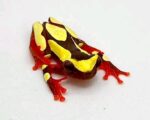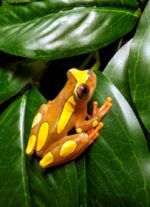Description
A Clown Tree Frog For Sale (or treefrog) is any species of frog that spends a major portion of its lifespan in trees, known as an arboreal state. Several lineages of frogs among the Neobatrachia suborder have given rise to treefrogs, although they are not closely related to each other.
Millions of years of convergent evolution have resulted in very similar morphology even in species that are not very closely related. Furthermore, Clown Tree Frog For Sale in seasonally arid environments have adapted an extra-epidermal layer of lipid and mucus as an evolutionary convergent response to accommodate the periodic dehydration stress.
Description of Clown Tree Frog For Sale


As the name implies, these frogs are typically found in trees or other high-growing vegetation. They do not normally descend to the ground, except to mate and spawn, though some build foam nests on leaves and rarely leave the trees at all as adults, and Eleutherodactylus has evolved direct development and therefore does not need water for a tadpole stage.
Tree frogs are usually tiny as their weight has to be carried by the branches and twigs in their habitats. While some reach 10 cm (4 in) or more, they are typically smaller and more slender than terrestrial frogs.
Tree frogs typically have well-developed discs at the finger and toe tips, they rely on several attachment mechanisms that vary with circumstances, Clown Tree Frog For Sale require static and dynamic, adhesive and frictional, reversible and repeatable force generation; the fingers and toes themselves, as well as the limbs, tend to be rather small, resulting in a superior grasping ability. The genus Chiromantis of the Rhacophoridae is most extreme in this respect: it can oppose two fingers to the other two, resulting in a vise-like grip.
Family of Clown Tree Frog For Sale
Tree frogs are members of these families or genera:
- Hylidae, or “true” treefrogs, occur in the temperate to tropical parts of Eurasia north of the Himalayas, Australia and the Americas.
- Rhacophoridae, or shrub frogs, are the treefrogs of tropical regions around the Indian Ocean: Africa, South Asia and Southeast Asia east to Lydekker’s line. A few also occur in East Asia.
- Centrolenidae, or glass frogs, are potentially closely related to hylids; these translucent frogs are native to Central and South America.
- Hyperoliidae, or reed frogs, are closely related to the burrowing Microhylidae; these small frogs are native to sub-Saharan Africa.
- Boophis is a genus of highly arboreal Clown Tree Frog For Sale which evolved from the toxic terrestrial Mantellidae of Madagascar.
A frog is any member of a diverse and largely semiaquatic group of short-bodied, tailless amphibian vertebrates composing the order Anura (coming from the Ancient Greek ἀνούρα, literally ‘without tail’). Frog species with rough skin texture due to wart-like parotoid glands tend to be called toads, but the distinction between frogs and toads is informal and purely cosmetic, not from taxonomy or evolutionary history.
Frogs are widely distributed, ranging from the tropics to subarctic regions, but the greatest concentration of species diversity is in tropical rainforest and associated wetlands. They account for around 88% of extant amphibian species, and are one of the five most diverse vertebrate orders. The oldest fossil “proto-frog” Triadobatrachus is known from the Early Triassic of Madagascar (250 million years ago), but molecular clock dating suggests their divergence from other amphibians may extend further back to the Permian, 265 million years ago.






















Reviews
There are no reviews yet.